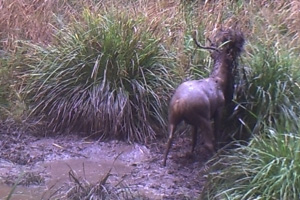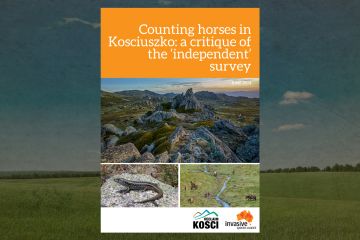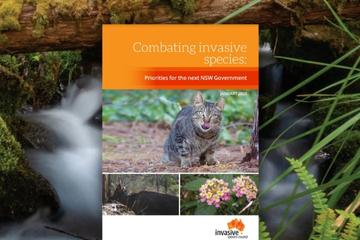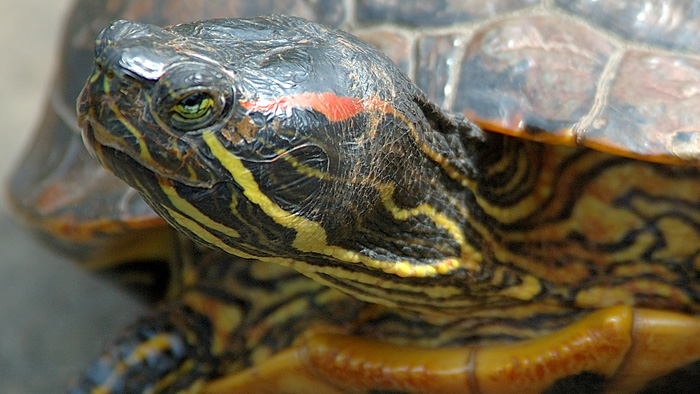
Solving invasive species is a wicked problem and the NSW government response to an independent pest management review bears this out.
A review to reform
A year-long pest review was conducted by the independent NSW Natural Resources Commission and included two rounds of consultation that generated almost 600 submissions. The review covered vertebrate terrestrial and freshwater species and sought to identify barriers to effective pest management and emerging risks as well as better coordination of investment. It determined that the widespread pests carp, rabbits, pigs, foxes, wild dogs, goats and introduced birds in NSW cost $170 million each year, a highly conservative figure that did not consider future risks and ignored environmental damage.
Unexpectedly, every regional workshop identified feral deer impacts as an important and growing issue.
The commission’s final 33 recommendations covered governance and policies, risk management, engagement, knowledge, funding and improved pest control. While a theme of the report includes empowering people to solve the problem, helping people understand their obligations and holding all land managers to account, the commission advised government must also maintain a role.
The commission said governments are “best placed to lead the management of incursions and should aspire to ensure no new pest animal populations are established in NSW”. This leadership role extends to setting biosecurity policy, as a public land manager to “cultivate the trust on which shared responsibility is based”, undertake research and to lead when responding to new incursions.
NSW government responds
Disappointingly, the government response to the report in June was largely a business as usual approach. Only ten of the recommendations were adopted. There will be changes with the development of new regional pest plans in 2018 and the NSW Biosecurity Act that starts on 1 July 2017. Without strong direction from government it is unclear how these measures will lead to the needed changes.
Key NRC recommendations and the NSW government response
| Recommendation | Response | Rationale | Our verdict |
| No new pests in NSW. | Accepted in principle. | ‘[p]reventing the establishment of new pests is more cost–effective than ongoing management if pests do become established and widespread’. | No new meaningful measures to reduce the risk of this happening. |
| Regulate invasive freshwater fish, reptile and amphibian pets. | Rejected. | A national policy on ornamental fish has been finalised. Controls are an ‘unnecessary and unreasonable regulatory burden on the aquarium and pet shop industry and on Government.’ | High risk legal and illegal aquatic pets are likely to establish in the wild in coming years. There is no evidence of an update to the unimplemented 2006 plan. The working group that prepared the 2006 plan stated ‘unless there is a consistent, national approach to regulate and manage the industry, the ad hoc approach taken to date will continue, with the likely outcome of further exotic invasions and disease threats to Australian fisheries and aquaculture industries.’
There is no plan to eradicate the eight recorded red-eared slider turtle populations in the Sydney and Lismore areas or to arrest the spread of redfin perch. |
| Remove seven exotic birds from the game bird list. | Rejected. | It is an offence to release these birds under the Game and Feral Animal Control Act and new Biodiversity Conservation Act. | These birds have formed feral populations overseas. Encouraging hunting of the birds will promote illegal and accidental release. |
| Align controls on high risk pets to national risk assessment, otherwise publicly justify any variation. | Rejected. | The NSW Biosecurity Act and its regulations are a ‘robust risk‑based categorisation of non‑indigenous terrestrial vertebrates.’ | Over 200 exotic species categorised nationally as an extreme threat of establishing are to be unregulated under the NSW Biosecurity Act. While some species are already widespread, a large proportion are still to establish in NSW or are found in small populations.
There is a need to phase out the owning of high risk invasive animal pets such as ferrets and Indian ringneck parrots. |
| Cats to be listed as a pest. mandatory controls on cats to require registration of non desexed cats, allowing landowners to trap stray cats and other measures. | Supported ‘in principle’. | Stronger controls are not necessary. Government has setup a new online pet registry. Pet breeders need to microchip cats and dogs prior to sale and councils have access to $900,000 grants to support microchipping, registration and de-sexing. Government will ‘create stronger incentives’ to promote desexing. | State and territory environment ministers agreed to stronger standardised regulation in 2016. These measures do not quickly drive more responsible cat ownership or strongly support council and land manager efforts to reduce feral cat impacts. |
| Retain pest control orders to prevent the keeping and moving of existing pests – rabbits, pigs, foxes, wild dogs and camels. | Rejected. | Pest orders are to be replaced with more specific measures in regional pest plans and the application of the ‘general biosecurity duty’. | Unlikely to be improved pest management. There will be confusion and lower level of coordinated land manager action without a strong education campaign and clear standards. |
| Small landholders (2-10 ha) to pay rate for pest coordinator per Local Land Services region and rapid response fund. | Partly rejected. | Landholders above 10 ha to continue to pay pest levy at same level. Part of pest insect levy left over after locust management can be repurposed for other pest management. | Landholders between 2 and 10 hectares will not be contributing to region-wide pest activities. Without new resources, Local Land Services are unlikely to have capacity to assist with awareness, coordination and compliance. |
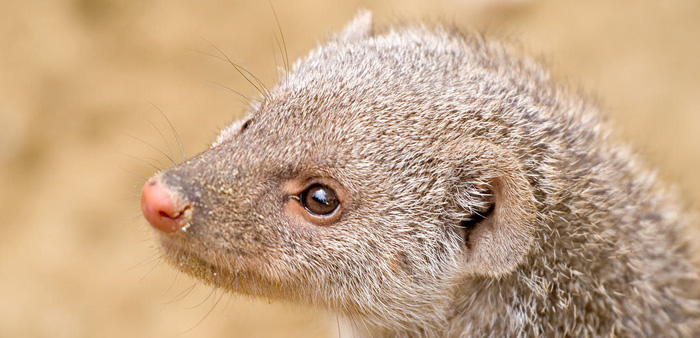
Let the deer spread
Particularly worrying was the slow progress in addressing the spread of feral deer.
Our own analysis has found that the area of NSW covered by deer had increased by 60% over the past six years. Feral deer now occupy about 13% of NSW, or half of eastern NSW. Not only do deer cause major environmental damage through their large grazing appetites, hard hooves, antler rubbing and wallows, but they are increasingly eating paddock grass, damaging crops and farm fences and causing traffic accidents. In the Illawarra there were nine deer-collision fatalities over a seven-year period.
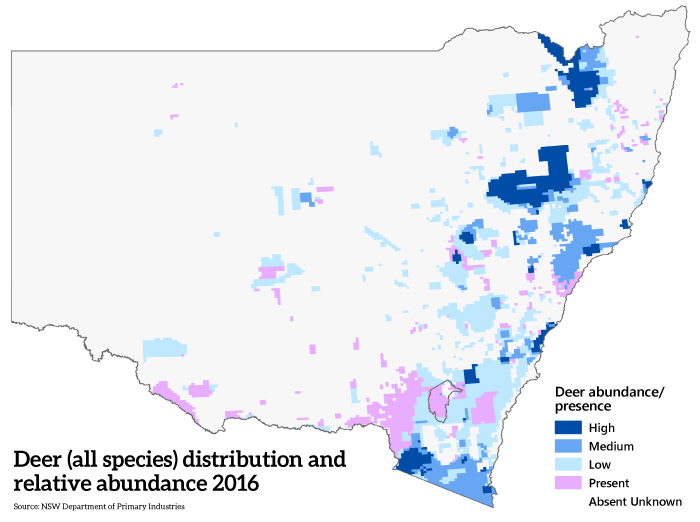
In April we led a delegation of land managers to brief NSW parliamentarians about the need for change to feral deer management. Our delegation was made up of land managers from southern NSW frustrated at hunting rules designed to limit deer control. The farmers talked about repeatedly spending late nights shooting deer, Landcare members talked about seeing planted trees killed after being eaten or rubbed and the Wollongong City Council mayor explained the dangers and inconveniences faced by residents living close to bushland areas.
The government rejected the Natural Resources Commission recommendation to lift the game status for feral deer that would have freed up public and private land managers to control deer like any other pest animal.
Progress on deer and game birds valued by recreational hunters was hamstrung by the disproportionate influence of the Shooters Party in the NSW parliament’s upper house where they share the balance of power.
Government did concede some ground, partly in response to the issues raised by the parliamentary delegation. Restrictions on land managers were partly lifted in nine local government areas in the southeast, Upper Hunter, Northern Tablelands and Central Coast. This will allow land managers in these areas to use contractors, volunteers and neighbours to shoot feral deer on their properties at night and with spotlights. These shooters would still need a hunting licence and membership of a hunting club.
The lawlessness of many hunters made the issue highly charged. The fear of reprisals prevented many land managers from speaking out about their unsavoury experiences with legal and illegal hunters. Even the government was unwilling to publish maps indicating the location of each of the six deer species in NSW because it feared hunters would trespass on private property to target their desired deer species.
A state deer plan will be developed this year, along with regional pest plans that may include specific measures to address deer problems at a local level such as the removal of hunting restrictions.
It will be too little, too late and the reverse of the preventative approach. Instead of a plan to contain feral deer within certain parts of the state, eradicate small populations and address deer farm escapees, control measures will only be introduced after deer have an ‘adverse impact’.

